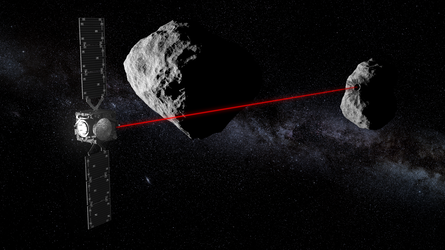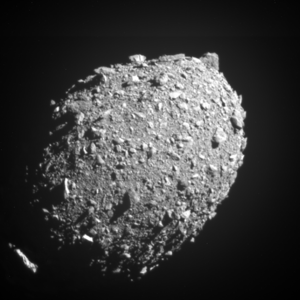Target asteroid
The target of the Hera mission is asteroid 65803 Didymos (1996 GT), an Apollo-type rocky (S-type, for astronomers) near-Earth object (NEO) with a perihelion (minimum distance to the Sun) that is just below the aphelion radius (maximum distance to the Sun) of Earth orbit.
Didymos is a binary asteroid; the primary body has a diameter of around 780 m and a rotation period of 2.26 hours, whereas the Dimorphos secondary body has a diameter of around 151 m and rotates around the primary at a distance of around 1.2 km from the primary surface in around 12 hours.
Dimorphos was the subject of a kinetic impact by the NASA DART spacecraft on 26 September 2022.
Prior to DART’s impact, it took Dimorphos 11 hours and 55 minutes to orbit its larger parent asteroid, Didymos. Since DART’s intentional 6.1 km per second collision with Dimorphos on 26 September, astronomers have confirmed the spacecraft’s impact altered Dimorphos’ orbit around Didymos by 32 minutes, shortening the 11 hour and 55-minute orbit to 11 hours and 23 minutes. This measurement has a margin of uncertainty of approximately plus or minus a minute.
DART’s collision has also been modelled to have possibly left a sizeable (20 m diameter scale) crater on Dimorphos’s surface. Mapping the shape of this crater will provide unique information to validate the numerical impact models necessary to design asteroid deflection missions in future. In addition, it will shed light on on the asteroid’s surface properties and internal structure. Is the asteroid a monolithic mass or a rubble pile? Is it composed of large or tiny grains? Is the subsurface composition identical to the surface one?

Hera will map Dimorphos’s entire surface down to a size resolution of a few metres, and the tenth of the surface surrounding the DART crater down to better than 10 cm resolution, through a series of daring flybys. It will also map much of the surface of the primary Didymos asteroid, providing crucial scientific data from two asteroids in a single mission.
Because Dimorphos is in close orbit around Didymos, the change to its orbit is easier to observe – initially from the ground – compared to performing a comparable test on an individual asteroid. A full picture of the collision and resulting momentum transfer will only become possible once Hera maps the mass of Dimorphos to a high level of certainty, which is necessary for scientists’ models of the tiny two-body system.
Hera’s single most important scientific result is expected to be an estimate of Didymoon’s mass, with an uncertainty of less than 10% -- which is only possible by flying to it.

The conventional method of deriving its mass through tracking its gravitational effect on a spacecraft’s trajectory is not workable here: swamped by the gravitational field of its massive parent asteroid, Didmorphos is too small to have an easily measurable effect on Hera or any other spacecraft. Instead, the idea is to estimate the mass of the secondary body by measuring the ‘wobble’ it causes its parent, relative to the common centre of gravity of the overall Didymos two-body system.
This will be achieved by identifying fixed landmarks on the surface of Didymos, such as boulders, and mapping small metre-scale variations in their rotation around the centre of gravity over time, while also taking account of spacecraft motion due to gravitational disturbance or the slight but steady effect of solar radiation pressure.
As an independent check of Dimorphos’s mass, the conventional method of mass determination will also be attempted later in the mission, through a very close, less-than-2-km-away flyby to assess that will reveal any effect of Dimorphos’s mass on Hera’s radio signals.
The 151-m diameter of Dimorphos also holds significance: the majority of 1 km-class near-Earth asteroids in our Solar System have been detected and mapped, but the majority of asteroids of this smaller size (and there are up to 30 000 of them) are yet to be discovered, despite their ‘city-killing’ potential. So this orbital shifting experiment has been performed on a class of asteroid that poses a real threat, providing valuable data if such an orbital deflection is ever required for real.
Finally it is important to note that the Didymos asteroid pair poses no threat to Earth, only coming to within 10 million km of Earth during their 2022 close encounter, making them the ideal candidate for such orbital deflection experiments and crucial science.















 Germany
Germany
 Austria
Austria
 Belgium
Belgium
 Denmark
Denmark
 Spain
Spain
 Estonia
Estonia
 Finland
Finland
 France
France
 Greece
Greece
 Hungary
Hungary
 Ireland
Ireland
 Italy
Italy
 Luxembourg
Luxembourg
 Norway
Norway
 The Netherlands
The Netherlands
 Poland
Poland
 Portugal
Portugal
 Czechia
Czechia
 Romania
Romania
 United Kingdom
United Kingdom
 Slovenia
Slovenia
 Sweden
Sweden
 Switzerland
Switzerland












































